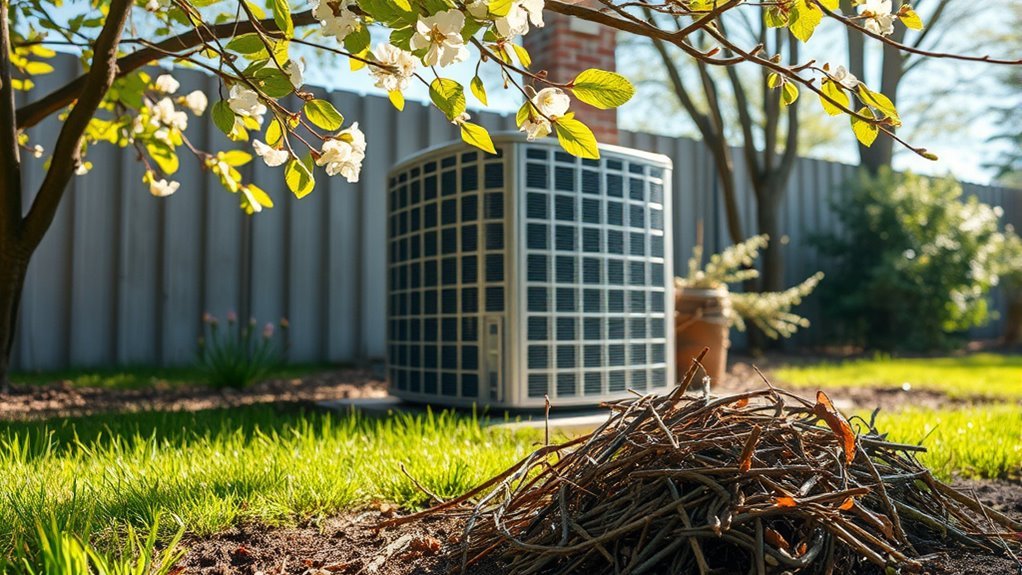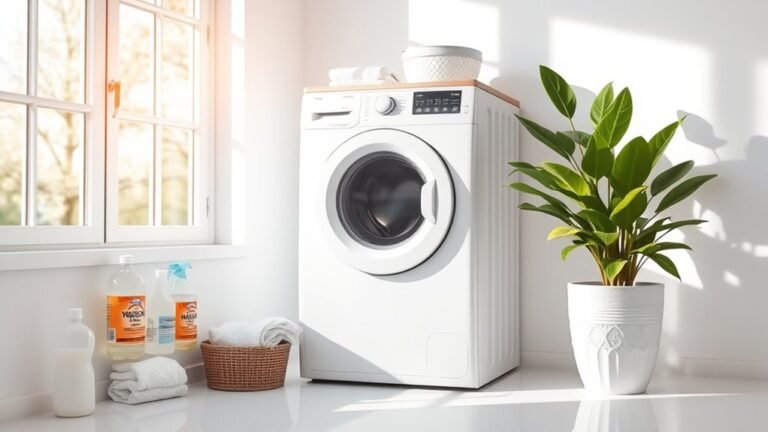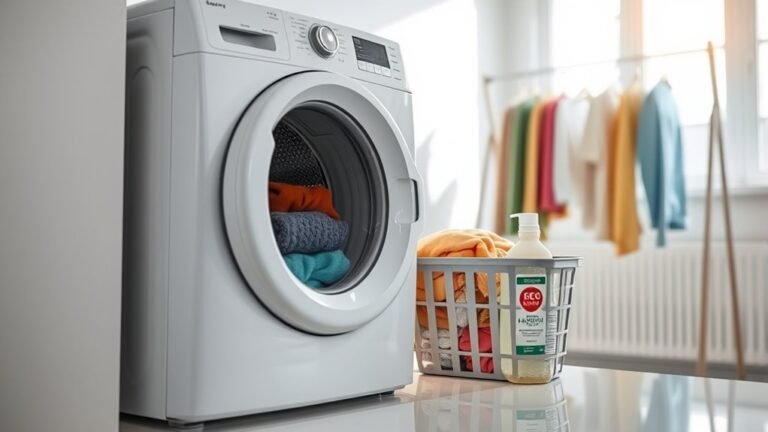Preparing Your Home’s HVAC System for Spring
To prepare your home’s HVAC system for spring, start by inspecting and cleaning or replacing air filters to keep airflow smooth. Adjust your thermostat settings for energy efficiency, and check ductwork for leaks to improve performance. Remove debris around outdoor units and clean drain lines to prevent clogs. Don’t forget to lubricate moving parts if needed and assess insulation to reduce drafts. Monitoring indoor air quality also helps maintain a healthy home. Keep these steps in mind as you explore ways to optimize your system.
Inspect and Clean Air Filters
One of the easiest ways to improve your HVAC system’s efficiency this spring is by inspecting and cleaning your air filters. You’ll want to understand the different air filter types available—from fiberglass to pleated filters—each offering various levels of filtration and airflow. Choosing the right filter affects not only your system’s performance but also your indoor air quality. Don’t wait until the filter looks dirty; regular filter replacement is key to maintaining freedom from unexpected breakdowns or poor air circulation. Checking your filters monthly lets you decide if a quick cleaning suffices or if it’s time for a replacement. Taking control of this simple task guarantees your HVAC runs smoothly, giving you the freedom to enjoy a comfortable, fresh home environment all season long.
Check Thermostat Settings
Now’s a great time to check your thermostat settings to keep your home comfortable and energy-efficient. If you have a programmable thermostat, adjusting it for spring can save you money and hassle. Be sure to set ideal temperatures and update schedules to match the season’s needs.
Optimal Temperature Settings
Setting your thermostat to the right temperature is key to keeping your home comfortable while saving energy this spring. You want to strike a balance between comfort and efficiency, giving yourself freedom from high energy bills. Aim for around 78°F when you’re home and active—this temperature offers effective temperature control without overworking your HVAC system. When you’re away or sleeping, raise the temperature a few degrees to boost energy efficiency without sacrificing comfort. Avoid drastic changes, as they can strain your system and waste energy. By fine-tuning your thermostat to these ideal settings, you’ll enjoy a cozy home that respects your desire for freedom and smart energy use. This simple adjustment helps maintain comfort while keeping your utility costs in check.
Programmable Thermostat Benefits
Although adjusting your thermostat manually can work, using a programmable thermostat makes it much easier to maintain consistent comfort and energy savings. You gain precise temperature control without constantly fiddling with settings, freeing you to focus on what matters most. These devices let you set schedules that match your lifestyle, ensuring your HVAC runs only when needed, reducing waste and utility bills.
| Feature | Benefit | Why It Matters |
|---|---|---|
| Scheduled Control | Automates temperature shifts | Saves energy effortlessly |
| Remote Access | Adjust settings anywhere | Freedom to control anytime |
| Custom Programs | Tailored comfort zones | Personalized comfort |
| Energy Reports | Track usage patterns | Optimize energy savings |
| Easy Interface | Simple to program | Hassle-free operation |
With a programmable thermostat, you enjoy smart, efficient temperature control that fits your life.
Seasonal Adjustment Tips
After enjoying the convenience of a programmable thermostat, it’s important to update your settings as the seasons change. Proper seasonal adjustment is key to spring maintenance and maximizing energy efficiency, giving you more control and freedom over your home’s climate.
Here’s how to get started:
- Set your thermostat to a higher temperature during the day when you’re away to save energy.
- Lower the temperature slightly at night for comfortable, cost-effective sleeping.
- Review your programmable schedule and adjust for longer daylight hours and warmer temperatures.
- Consider enabling “auto” mode to let your system switch between heating and cooling as needed.
These simple tweaks help you enjoy spring’s freedom without wasting energy or money.
Examine Ductwork for Leaks
Ductwork plays an essential role in delivering conditioned air throughout your home, so it’s important to check for leaks before the spring season begins. You want your HVAC system to work efficiently, providing comfort without wasting energy. Start by performing an airflow assessment—feel for weak spots or uneven air distribution in different rooms. If you notice any, it’s likely that leaks in the ductwork are letting air escape. Taking action with proper duct sealing not only boosts your system’s performance but also gives you more control over your indoor environment. Fixing leaks frees you from unnecessary energy costs and guarantees your HVAC system delivers the freedom of consistent, reliable comfort as temperatures rise. Don’t overlook this step to keep your home’s air flowing smoothly this spring.
Clear Debris Around Outdoor Units

To keep your HVAC running smoothly, start by removing leaves and twigs from around the outdoor unit. You’ll also want to trim back any nearby vegetation to guarantee proper airflow. Clearing this debris helps prevent damage and improves efficiency.
Remove Leaves and Twigs
Three simple steps can make a big difference in your HVAC system’s efficiency: removing leaves, twigs, and other debris from around your outdoor unit. Leaf accumulation effects include blocking airflow and causing the system to work harder, which increases energy costs and wear. To keep your unit running freely, follow these twig removal techniques:
- Turn off the HVAC power to guarantee safety.
- Use gloves to pick up leaves and twigs without injury.
- Gently brush away debris from the unit’s fins and coils.
- Dispose of the gathered debris to prevent it from blowing back.
Clearing this clutter lets your system breathe easy, giving you the freedom to enjoy spring without HVAC worries.
Trim Nearby Vegetation
A few feet of clear space around your outdoor HVAC unit can make a big difference in its performance. Effective vegetation management guarantees your system breathes freely, boosting efficiency and preventing damage. Start by trimming back any overgrown shrubs, branches, or tall grasses that crowd the unit. This not only improves airflow but also reduces the risk of debris clogging the coils. When choosing plants nearby, focus on smart plant selection—opt for low-growing, non-invasive species that won’t spread into your unit’s space. Keeping a tidy perimeter around the HVAC system gives you freedom from unnecessary repairs and energy waste. By maintaining clear surroundings, you’re taking control of your home’s comfort and guaranteeing your system runs smoothly all spring and beyond.
Schedule Professional HVAC Maintenance
One important step you shouldn’t skip is scheduling professional HVAC maintenance before spring arrives. This guarantees your system runs smoothly and efficiently all season. A trusted technician will follow an HVAC checklist to catch issues early, saving you from unexpected breakdowns and costly repairs.
Here’s what you can expect from professional maintenance:
- Thorough inspection of components.
- Cleaning of coils and filters.
- Checking refrigerant levels.
- Testing electrical connections.
These maintenance benefits not only extend your system’s lifespan but also boost energy efficiency, giving you freedom from high utility bills. You’ll enjoy peace of mind knowing your HVAC is ready for warmer days ahead, so you can focus on what matters most—your comfort and freedom.
Test the Air Conditioner Functionality
Before the temperatures rise, you’ll want to test your air conditioner to confirm it’s working properly. Start by turning it on and paying attention to the airflow assessment. Make sure the air is strong and steady from the vents—weak airflow could signal a blockage or fan issue that limits your freedom to stay cool. Next, check the temperature calibration by feeling if the air coming out is noticeably cooler than the room air. If it isn’t, your system might need adjustment or repair to maintain peak comfort. Testing now means you avoid unexpected breakdowns when you want to relax. Taking these simple steps gives you control over your environment and guarantees your AC is ready to keep you cool all spring and summer.
Clean and Inspect Drain Lines
While your HVAC system works to keep air cool and comfortable, drain lines quietly carry away condensation that builds up during operation. Ignoring this part can lead to water damage and costly repairs. To keep your system running smoothly and maintain your freedom from unexpected issues, follow these maintenance tips:
- Locate the drain line and check for visible blockages or leaks.
- Flush the drain line with a mixture of water and vinegar to clear any buildup.
- Use a wet/dry vacuum to remove stubborn clogs from the drain line’s end.
- Regularly inspect the drain pan to verify it’s draining properly and not overflowing.
Taking these steps helps you avoid disruptions and keeps your HVAC system efficient all spring long.
Lubricate Moving Parts if Needed
Keep your HVAC system running smoothly by lubricating its moving parts when necessary. This simple step reduces friction and wear, helping your system operate efficiently and quietly. Check your maintenance schedule to see if lubrication is recommended for your model and which parts need attention, like motor bearings and fan shafts. Use proper lubrication techniques, applying the right type and amount of lubricant to avoid overdoing it or missing spots. If you’re unsure, consult your HVAC manual or a professional to guarantee you’re doing it correctly. Staying on top of lubrication not only prolongs your system’s life but also gives you the freedom to enjoy consistent comfort without unexpected breakdowns. Regular care means your home stays cozy all season.
Assess Insulation and Sealing
After making sure your HVAC system’s moving parts are well-lubricated, it’s a good idea to check your home’s insulation and sealing. Proper insulation types and sealing techniques help maintain your freedom from drafts and high energy bills. Here’s how you can take control:
- Identify gaps around doors and windows where air sneaks in.
- Choose insulation types that match your climate—like spray foam for tight sealing or fiberglass for easy installation.
- Apply sealing techniques such as weatherstripping or caulking to block unwanted airflow.
- Inspect your attic and basement for damaged or missing insulation and repair as needed.
Monitor Indoor Air Quality
Since the air inside your home can be up to five times more polluted than outdoor air, monitoring indoor air quality is essential for your health and comfort. You can boost fresh air by adding indoor plants, which naturally filter toxins, or use air purifiers to trap dust and allergens. Keeping an eye on humidity and ventilation also helps maintain a clean atmosphere. Here’s a quick guide:
| Action | Benefit | Tip |
|---|---|---|
| Indoor Plants | Natural air filtration | Choose spider plants or ferns |
| Air Purifiers | Remove pollutants | Use HEPA filters |
| Ventilation | Fresh air circulation | Open windows regularly |
| Humidity Control | Prevent mold growth | Use a dehumidifier |
| Regular Cleaning | Reduce dust & allergens | Vacuum and dust weekly |
Stay proactive, and breathe easier this spring!
Frequently Asked Questions
How Often Should I Replace My HVAC System Entirely?
You should consider HVAC system replacement every 15 to 20 years, as that’s typically the average HVAC lifespan. If your system’s constantly breaking down or energy bills are soaring, it’s probably time to break free from old equipment and upgrade. Don’t wait for a total breakdown—planning ahead gives you the freedom to choose a more efficient, reliable system that fits your needs and budget.
Can I Upgrade My HVAC System for Better Energy Efficiency?
You can definitely upgrade your HVAC system to boost energy efficiency. Thanks to HVAC technology advancements, there are plenty of energy saving upgrades available that let you enjoy better comfort while cutting utility costs. By choosing modern, smart systems, you gain more control and freedom over your home’s climate. These upgrades not only save energy but also give you peace of mind knowing you’re using the latest, most efficient technology out there.
What Are the Signs of Refrigerant Leaks in My AC?
Think of your AC as a balloon slowly losing air—those refrigerant symptoms signal it’s deflating. You might notice warm air blowing, ice buildup on coils, or your energy bills creeping up. These clues are key for leak detection, helping you spot trouble before it grounds your comfort. By catching refrigerant leaks early, you keep your freedom to enjoy cool, worry-free days without unexpected breakdowns.
How Do I Choose the Right HVAC System Size for My Home?
When choosing the right HVAC system size for your home, you’ll want to focus on HVAC sizing that matches your space perfectly. Too big or too small can mess with your home comfort and energy bills. Consider factors like your home’s square footage, insulation, and local climate. You can use a professional load calculation or consult an expert to guarantee freedom from discomfort and unnecessary costs. That way, you’ll enjoy a cozy, efficient system all year.
Are There Any Tax Credits for Installing Energy-Efficient HVAC Units?
Imagine Sarah, who upgraded to an energy-efficient HVAC last year and saved big thanks to energy incentives. You can do the same! Many states and the federal government offer tax deductions or credits when you install qualifying units. These energy incentives not only cut your upfront costs but also free you from excessive bills down the road. So, check local programs and IRS guidelines—you might be surprised how much freedom those savings bring to your budget.






